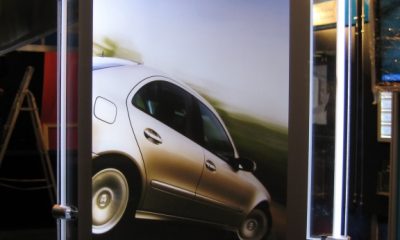Come January 11, 2011, sign companies will need to monitor – or no longer use – any paints or primers that contain chromium (Cr), lead (Pb), manganese (Mn), nickel (Ni) or cadmium (Cd). This is part of the National Emission Standards for Hazardous Air Pollutants (NESHAP), Subpart HHHHHH. (The metals are referred to as HAPs.) New users must have been compliant since July 7, 2008, or within 180 days of startup.
My first reaction was, once again, the sign industry is being hit by regulations largely intended for the massive users, not little old sign companies. Secondly, I heard “sprayed,” and I heard “vehicles,” and I had to stop for a minute before I realized this is mostly about spraying the vehicle’s base color. It has nothing to do with vehicle graphics. It does concern coatings that are sprayed, especially on metal surfaces.
I traded some emails with Jan Scheske, Matthews Paints’ manager of marketing and customer service. She confirmed that none of these metals appear in their sign paints, but they are in some primers.
Jan forwarded me a comment from John Brandmeier, Matthews’ director of business development and sales: “While sign companies may choose to continue using HAP-containing materials and take the necessary steps to manage their usage, there are alternative, non-HAP-containing coatings available on the market. For MPC users, 6H impacts use of our acid-etch primers. There are various other primer options, including epoxies and a new, chromium-free, low-VOC, acid-etch primer [74 350SP].”
More importantly, perhaps, Brandmeier advised, the federal regulations are one thing, but local interpretation is gospel: “If you have questions regarding the rulings, contact your local EPA representative for clarification. The EPA rep’s interpretation is the ONLY one that counts, and local requirements may modify or supersede national requirements.”
According to a very interesting FAQ pamphlet released to Spraylat’s sales and marketing personnel, the requirements merely enforce good work practices that should already exist. Again, while the following advice may primarily refer to non-sign applications, it still generally applies.
Kevin Cappo, the corporate environmental health and safety director for Spraylat, wrote, “If you use good work practices already, this is no big deal. There are no restrictions on what you use [but you need to try to use less methylene chloride]. You can use all of the materials you’ve always used. If you don’t use good work practices, you have to pull yourself into the 21st Century. The good work practices will make your business more efficient, saving paint and filters, as well as being safer for employees and the environment.”
He outlines four requirements that should already be occurring:
1. Notifying the Environmental Protection Agency (EPA) of your usage and submitting an annual report;
2. Certifying every five years that your sprayers are using good work practices;
3. Showing that you’re using appropriate equipment; and
4. Keeping track of records that you should already have.
There are exemptions, but none of these seem to really concern sign companies. These include Title V companies (who have local permits related to the Clean Air Act), any work for the U.S. military, and any work for R&D or quality control.
Similarly, there are regulations for spray booths, but these seem to only pertain to the spraying of vehicles. Spray-booth filters must capture at least 98% of any overspray. The spray booths must have a ceiling and three sides, with ventilation such that air is drawn into the booth. Cleaning of spray guns must occur in a container in order to collect the solvent. Again, this simply makes sense, regardless of any regulation.
At the April ISA show in Orlando, Akzo Nobel had copies of the EPA-issued Final Rule, a six-page, folded pamphlet. It can also be found online at www.epa.gov/ttn/atw/area/arearules.html. It includes contact information for 10 regional EPA offices.
In the pamphlet, under the heading of “What Am I Required to Do?,” the two subheads are “Paint Stripping Operations” and “Motor Vehicle/Mobile Equipment/Miscellaneous Surface Coating Operations,” so clearly, sign primers aren’t really the target, but, as alluded to initially, something that gets lumped in with other coatings.
On its website, the International Sign Assn. has the entire, 163-page Final Rule: www.signs.org/Portals/0/docs/EPA_SUMMARY.pdf.
Overall, NESHAP Subpart HHHHHH doesn’t really seem to impact the sign industry. Not just because it’s the law, but because it’s the right thing to do, check with your local EPA representative to make sure.

 Projects1 week ago
Projects1 week ago
 News1 week ago
News1 week ago
 How To1 week ago
How To1 week ago
 Real Deal2 days ago
Real Deal2 days ago
 Editor's Note3 days ago
Editor's Note3 days ago
 News2 days ago
News2 days ago
 Product Buying + Technology4 days ago
Product Buying + Technology4 days ago
 News1 week ago
News1 week ago













